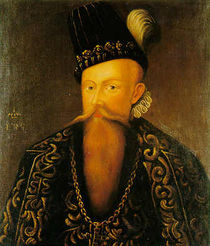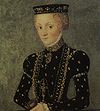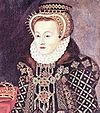John III of Sweden
| John III | |
|---|---|
 |
|
| John III portraited by Dutch artist Johan Baptista van Uther in 1582. | |
|
|
|
| Reign | 29 September 1568 – 17 November 1592 (24 years, 49 days) |
| Coronation | 10 July 1569 |
| Predecessor | Eric XIV |
| Successor | Sigismund |
| Spouse | Catherine Jagellonica Gunilla Bielke |
| Issue | |
| Sigismund III Vasa Anna John, Duke of Östergötland |
|
| House | House of Vasa |
| Father | Gustav I of Sweden |
| Mother | Margaret Leijonhufvud |
| Born | 20 December 1537 Stegeborg Castle |
| Died | 17 November 1592 (aged 54) Stockholm Castle |
| Burial | Uppsala Cathedral |
John III (Swedish: Johan III, Finnish: Juhana III) (20 December 1537 – 17 November 1592) was King of Sweden from 1568 until his death. He was the son of King Gustav I of Sweden and his second wife Margaret Leijonhufvud. He was also quite autonomously the ruler of Finland, as Duke John from 1556 to 1563. In 1581 he assumed also the title Grand Prince of Finland.
Contents |
Biography
He was the second son of Gustav Vasa (1523–1560). His mother was Margareta Leijonhufvud (1514–1551), a Swedish noblewoman. As a Duke of Finland he opposed his half-brother Eric XIV of Sweden (1560–1568) and was imprisoned in 1563. After his release from prison, probably because of his brother's insanity, John again joined the opposition, deposed Eric and made himself the king. His important ally was his maternal uncle Sten Leijonhufvud, who at deathbed was made Count of Raseborg. Shortly after this John executed his brother's most trusted counsellor, Jöran Persson, whom he held largely responsible for his harsh treatment while in prison.
John finished the Scandinavian Seven Years' War in 1570 without many Swedish concessions and during the following years he successfully fought Russia in the Livonian War, concluded by the Treaty of Plussa in 1583, a war that meant a Swedish reconquest of Narva. As a whole his foreign policy was affected by his connection to Poland of which country his son Sigismund III Vasa (1587–1632) was made king in 1587.
In domestic politics John showed clear Catholic sympathies, inspired by his Polish queen, a fact that created frictions to the Swedish clergy and nobility. He launched the "Red Book" which reintroduced several Catholic customs. In 1575, he gave his permission for the remaining Catholic convents in Sweden to start receiving novices again. From time to time he was also at odds with his younger brother Duke Charles of Sudermannia (afterwards Charles IX of Sweden). John III was an eager patron of art and architecture.
John III as king
In January of 1569, John was recognized as king by the same riksdag that forced Eric XIV off the throne. But this recognition was not without influence from John; Duke Karl received confirmation on his dukedom without the restrictions of his power that the Arboga articles imposed. The nobilities' power and rights were extended and their responsibilities lessened.
John was still concerned about his position as king as long as Eric was alive. The fear of a possible liberation of the locked up king worried him to the point that in 1571 he ordered the guards that in the event of any suspicion of liberation attempt to murder the captured king. It is possible this is how his life ended in 1577.
John III was reportedly like his father in propaganda, with repeated claims to have "liberated Sweden" from the "bloodhound" Christian II, as well as rescuing the population from the "tyrant" Eric XIV. He was reportedly violent, hot tempered and greatly suspicious.
Ancestors
|
|
|
|
|
Johan Kristiernsson (Vasa) | |||||
|
|
|||||||||
|
|
Erik Johansson (Vasa) |
|
|
||||||
|
|
|
||||||||
|
|
|
Birgitta Gustavsdotter (Sture) | |||||||
|
|
|||||||||
|
|
Gustav I of Sweden (Vasa) |
|
|
||||||
|
|
|
||||||||
|
|
|
Måns Karlsson (Eka) | |||||||
|
|
|||||||||
|
|
Cecilia Månsdotter (Eka) |
|
|
||||||
|
|
|
||||||||
|
|
|
Sigrid Eskilsdotter (Banér) | |||||||
|
|
|||||||||
| John III of Sweden |
|
|
|||||||
|
|
|||||||||
|
|
|
Abraham Kristiernsson (Leijonhuvud) | |||||||
|
|
|||||||||
|
|
Erik Abrahamsson (Leijonhufvud) |
|
|
||||||
|
|
|
||||||||
|
|
|
Birgitta Månsdotter (Natt och Dag) | |||||||
|
|
|||||||||
|
|
Margaret Leijonhufvud |
|
|
||||||
|
|
|
||||||||
|
|
|
Erik Karlsson (Vasa) | |||||||
|
|
|||||||||
|
|
Ebba Eriksdotter (Vasa) |
|
|
||||||
|
|
|
||||||||
|
|
|
Anna Karlsdotter (Vinstorpa) | |||||||
|
|
|||||||||
Family

John married his first wife, Catherine Jagellonica of Poland (1526–1583), house of Jagiello, in Vilnius on 4 October 1562. In Sweden she is known as Katarina Jagellonica and she was the sister of king Sigismund II Augustus of Poland. Their children were:
- Isabella (1564–1566)
- Sigismund King of Sweden (1592–1599), and King of Poland (1587–1632), Grand Duke of Finland and Lithuania
- Anna (1568–1625)

He married his second wife Gunilla Bielke (1568–c. 1592) on 21 February 1584 and together they had the son:
- John (Johan) (1589–1618), firstly Duke of Finland, then from 1608 Duke of Ostrogothia. The young duke married his first cousin Maria Elisabet (1596–1618), daughter of Charles IX of Sweden (reigned 1599–1611)
Together with his mistress Karin Hansdotter (1532–1596) he had at least four illegitimate children:
- Julius Gyllenhielm (1559–1581)
- Augustus (1557–1560)
- Sofia ( 1556–1583) who married Pontus De la Gardie
- Lucretia (1560–1585)
John cared for Karin and his children with her after he married with Catherine Jagellonica of Poland in 1562. He took care that Karin got a husband that should take care of her and his children. In 1561 Karin was married to a nobleman Klas Andersson (Västgöte), a friend and servant of John. Together they had a daughter named Brita. When John became King in 1568 he continued to support Karin and his illegitimate children. In 1572 Karin was married again, her earlier husband was murdered by Erik XIV in 1563, to a Lars Henrikson. In 1576 he was nobled by John if he took care about his issue with Karin. The same year he sent for his daughter Sofia to be a lady in the castle as a servant to his sister Princess Elisabet. In 1580, John married her off to Pontus de la Gardie. She later died giving birth to Jacob De la Gardie.
See also
- History of Sweden – Foundation of Modern Sweden
External links
References
- Signum svenska kulturhistoria: Renässansen (2005)
|
John III
House of Vasa
Born: 20 December 1537 Died: 17 November 1592 |
||
| Regnal titles | ||
|---|---|---|
| New creation | Duke of Finland 1556–1563 |
Succeeded by Eric XIV |
| Preceded by Eric XIV |
King of Sweden 1568–1592 |
Succeeded by Sigismund |
| Duke of Finland 1568–1592 |
Succeeded by John, Duke of Ostrogothia |
|
| New creation | Grand Duke of Finland 1581 – 1592 |
Succeeded by Sigismund |
|
|||||||||||||||||||||||||||||||||||||||||||||||||||||
|
|||||||||||||||||||||||||||||||||||||||||||||||||||||||